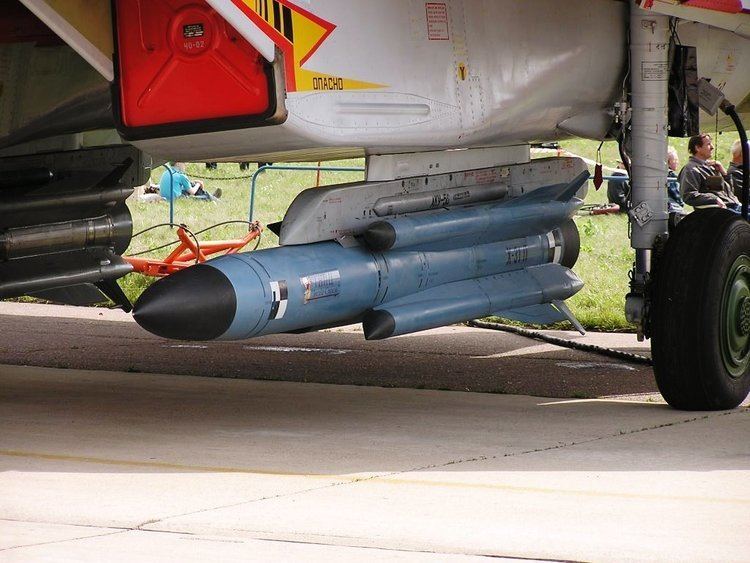Unit cost $550 000 (2010) | In service 1988–present | |
 | ||
Type Medium-range air-to-surface missile Manufacturer Tactical Missiles Corporation(Zvezda-Strela before 2002) | ||
The Kh-31 (Russian: Х-31; AS-17 'Krypton') is a Russian air-to-surface missile carried by aircraft such as the MiG-29 or Su-27. It is capable of Mach 3.5 and was the first supersonic anti-ship missile that could be launched by tactical aircraft.
Contents
There are several variants, it is best known as an anti-radiation missile (ARM) but there are also anti-shipping and target drone versions. There has been talk of adapting it to make an "AWACS killer", a long-range air-to-air missile.
Development
The proliferation of surface-to-air missiles (SAMs) has made the Suppression of Enemy Air Defence a priority for any modern air force intending offensive action. Knocking out air search radars and fire control radars is an essential part of this mission. ARMs must have sufficient range that the launch platform is out of range of the SAMs, high speed to reduce the risk of being shot down and a seeker that can detect a range of radar types, but they do not need a particularly big warhead.
The Soviet Union's first ARM was developed by the Raduga OKB engineering group responsible for the Soviet Union's missiles for heavy bombers. The Kh-22P was developed from the 6-tonne Raduga Kh-22 (AS-4 'Kitchen') missile. Experience gained with this led in 1973 to the Kh-28 (AS-9 'Kyle') carried by tactical aircraft such as the Su-7B, Su-17 and Su-24. It had Mach 3 capability and a 120 km (60 nmi) range, greater than the contemporary AGM-78 Standard ARM. The Kh-28 was succeeded by the Kh-58 in 1978, which has similar speed and range but replaces the dual-fuel rocket motor with a much safer RDTT solid propellant.
The development of more sophisticated SAMs such as the MIM-104 Patriot and the US Navy's Aegis combat system put pressure on the Soviets to develop better ARMs in turn. Zvezda came at the problem from a different angle to Raduga, having a background in lightweight air-to-air missiles. However, in the mid-1970s they had developed the successful Kh-25 family of short-range air-to-surface missiles, including the Kh-25MP (AS-12 'Kegler') for anti-radar use. Zvezda started work on a long-range ARM and the first launch of the Kh-31 was in 1982. It entered service in 1988 and was first displayed in public in 1991, the Kh-31P at Dubai and the Kh-31A at Minsk.
In December 1997 it was reported that a small number of Kh-31's had been delivered to China, but that "production had yet to begin". It was around this time that the Russians sold Su-30MKK 'Flanker-G' aircraft to the Chinese. It seems that the original deliveries were of the original Russian model designated as X-31, to allow testing whilst the KR-1 model was being developed for licence production. Local production may have started by July 2005.
Russian development has accelerated since Zvezda was subsumed into the Tactical Missiles Corporation in 2002, with the announcement of the 'D' extended range models and the 'M' model mid-life updates (see Variants section below).
Design
In many respects the Kh-31 is a miniaturised version of the P-270 Moskit (SS-N-22 'Sunburn') and was reportedly designed by the same man. The missile is conventionally shaped, with cruciform wings and control surfaces made from titanium. The two-stage propulsion is notable. On launch, a solid-fuel booster in the tail accelerates the missile to Mach 1.8 and the motor is discarded. Then four air intakes open up and as in the Franco-German ANS/ANF the empty rocket case becomes the combustion chamber of a kerosene-fuelled ramjet, which takes it beyond Mach 4.
The L-111E seeker of the anti-radar version has a unique antenna, an interferometer array of seven spiral antennas on a steerable platform. The seekers delivered to China in 2001-2 were 106.5 cm (41.9 in) long, 36 cm (14 in) in diameter, and weighed 23 kg (51 lb).
Operational history
The Kh-31P ARM entered service in Russia in 1988 and the Kh-31A anti-shipping version in 1989. Unlike its predecessors, it can be fitted to almost any of Russia's tactical aircraft, from the Su-17 to MiG-31.
In 2001 India bought Kh-31s for its Su-30MKI; they appear to have bought 60 Kh-31A and 90 Kh-31P. A few Kh-31P/KR-1's were delivered to China in 1997 but these were apparently for testing and development work. The Chinese ordered Russian missiles in late 2002 or early 2003, leading to 200 KR-1's in their inventory by 2005; the Chinese press reported in July 2005 that Su-30MKK's of the 3rd Air Division had been equipped with the missiles.
The US Navy bought MA-31 target drones. An $18.468-million order for thirty-four MA-31 was placed in 1999, but this order was blocked by the Russians. The MA-31 was launched from an F-4 Phantom, and work was done on a kit to launch it from an F-16.
According to some reports, the missile was used by the Russian Air Force during the South Ossetian conflict in 2008. In particular, it was reported that on August 10, 2008 a Russian Air Force Su-34 struck a Georgian air defense radar near the city of Gori with Kh-31P anti-radar missiles. Georgian air defenses were disabled in order to avoid further losses.
Variants
An active/passive air-to-air version for use against slow-moving support aircraft, a so-called "AWACS killer", was announced at the 1992 Moscow air show with 200 km (110 nmi; 120 mi) range. That would be less than the 300–400 kilometres (160–220 nmi; 190–250 mi) promised by the Vympel R-37 (AA-13 'Arrow') and Novator R-172 missiles, but a Kh-31 derivative could be carried by a wider range of aircraft. However this may have been mere propaganda; in 2004 the Tactical Missiles Corporation "emphatically denied" that it had ever worked on an air-to-air version of the Kh-31. In 2005 rumours persisted of a Russian AWACS killer based on the Kh-31A anti-shipping model, and of the Chinese adapting the YJ-91, derived from the Kh-31P, for the same purpose.
